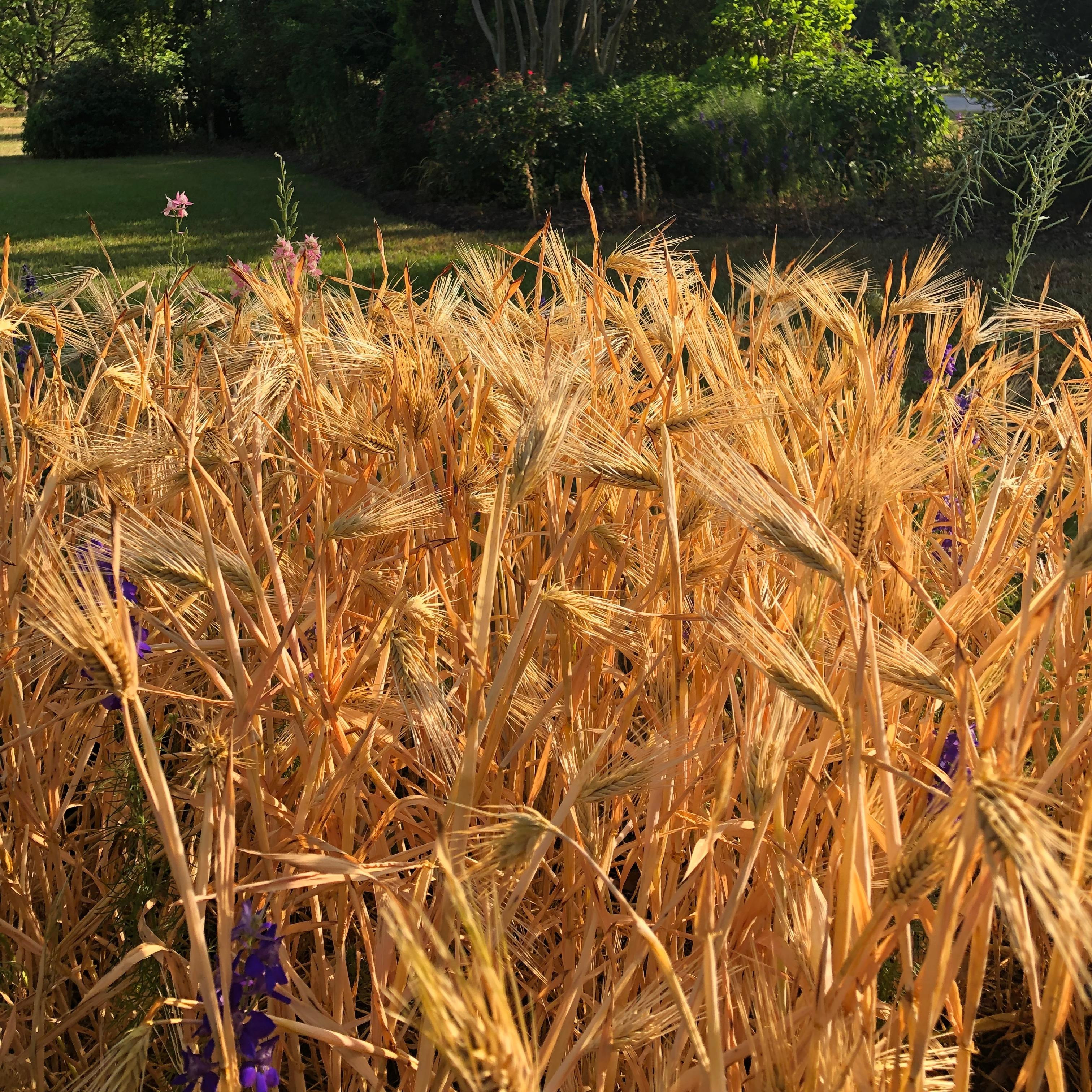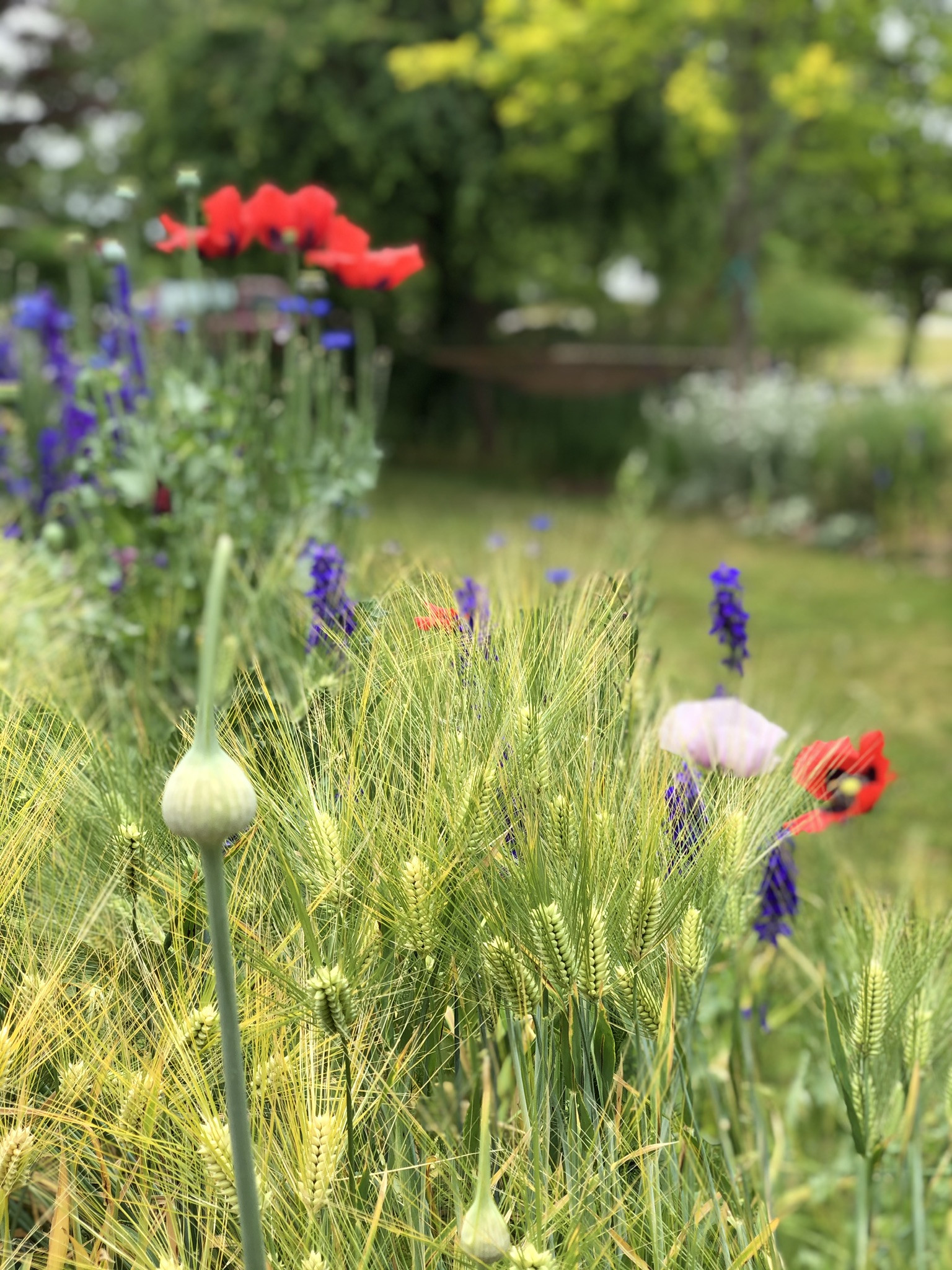Grass. It’s everywhere, often underfoot and underappreciated. But as a plant enthusiast, I can tell you that grass, in all its forms, holds a special place in the botanical world. From the meticulously manicured lawns we walk on to the swaying ornamental varieties that add beauty to landscapes, and even the nourishing grains that sustain us, grasses are indispensable. In fact, all of these diverse plants belong to one remarkable family: the Poaceae Family.
For over two decades, my passion for horticulture has only deepened my admiration for grasses. They are the unsung heroes of our ecosystems, performing critical functions that often go unnoticed. Grasses are essential for slowing water runoff, preventing soil erosion, and crucially, producing the very oxygen we breathe. It’s time to delve deeper into why the Poaceae family deserves our attention and respect.
Beyond “Grow Food Not Lawns”: Understanding the Role of Grass
The phrase “Grow Food Not Lawns” has gained traction, and while the sentiment for food security is valid, it sometimes overshadows the vital ecological roles that lawns and grasses play. While food production is paramount, dismissing lawns entirely overlooks their significant contributions to our environment and quality of life.
Imagine a world without grass – where would we walk, play, or picnic? Lawns provide accessible green spaces in our increasingly urbanized environments. I often find myself defending the value of lawns because their ubiquity makes it easy to take them for granted. In an age of instant judgment, it’s easy to assume that widespread grass cover is detrimental, but a closer look reveals a different story.
This expansive lawn area provides a versatile space for gatherings and enhances the visual appeal of the surrounding plantings.
The Multifaceted Attributes of Turfgrass within the Poaceae Family
Lawns, composed of turfgrass species within the Poaceae family, are essential components of sustainable living, especially in areas where humans and animals interact daily. Often taken for granted, turfgrass quietly provides a range of environmental benefits throughout the year.
1) Oxygen Production and Carbon Dioxide Absorption: A Poaceae Powerhouse
Like all members of the plant kingdom, grasses are photosynthetic organisms. They absorb carbon dioxide from the atmosphere and, through photosynthesis, release the oxygen vital for our survival. Lawns are exceptionally efficient oxygen producers. A mere 25 square feet of healthy turfgrass generates enough oxygen daily to meet the needs of one adult. Furthermore, lawns annually absorb about 5% of atmospheric carbon dioxide, playing a role in mitigating global warming. This crucial function highlights the Poaceae family’s contribution to a healthy atmosphere.
2) Erosion Control and Water Purification: Poaceae’s Protective Role
A thriving lawn is a highly effective natural defense against soil erosion caused by wind and excessive rainfall. This is particularly relevant in regions prone to heavy precipitation.
Turfgrasses, with their dense root systems characteristic of the Poaceae family, firmly anchor the soil. Simultaneously, the grass blades shield the topsoil from erosive forces. Moreover, turfgrass reduces runoff from paved areas, preventing pollutants from entering waterways and ultimately reaching the oceans. This filtration capacity underscores the Poaceae family’s role in maintaining water quality.
3) Temperature Regulation: The Cooling Effect of Poaceae
Through transpiration, a process of water evaporation from their leaves, grasses naturally cool their surroundings. This evaporative cooling effect results in significantly lower air temperatures compared to surfaces like concrete. On sunny days, the air above a lawn can be over 14 degrees cooler than above concrete, demonstrating the Poaceae family’s ability to moderate urban heat islands.
4) Enhanced Air Quality and Soil Health: Poaceae as Environmental Cleaners
Grasses act as natural air filters, trapping airborne pollutants such as dust, dirt, allergens, and more harmful contaminants. In the United States alone, turfgrasses cleanse the air of an estimated 12 million tons of impurities annually. They break down pollutants and enrich the soil with captured dust and dirt.
Organically managed lawns foster beneficial soil microorganisms, similar to those found in high-quality compost. These microorganisms, along with the organic matter produced by grass, improve soil structure and overall health. Healthy soil, in turn, supports healthy grass, amplifying the environmental advantages offered by the Poaceae family.
Sustainable Lawn Care Practices Rooted in Poaceae Biology
Many criticisms of lawns stem from conventional, often excessive, maintenance practices. However, by adopting sustainable approaches, we can minimize inputs and maximize the environmental benefits inherent in grasses.
1) Right Poaceae Species, Right Place:
Selecting the appropriate grass species for your climate and conditions is fundamental. For sunny areas in warmer regions, choose warm-season turfgrasses like Bermudagrass, Zoysiagrass, or Centipedegrass, which are naturally adapted to these environments. Resist the urge to force cool-season grasses in unsuitable climates. For the Southeast US, warm-season turfgrasses from the Poaceae family are generally the most suitable choice unless growing in heavily shaded areas. Consult resources like turfgrass selection filters to find the best option for your specific location.
2) Efficient Irrigation for Poaceae Health:
Water deeply and less frequently to encourage deep root growth. Shallow, frequent watering leads to shallow root systems, increasing water dependency. Deep, infrequent watering promotes robust, drought-tolerant root systems, a key characteristic of resilient Poaceae species. Adjust irrigation timers to reflect this principle.
3) Mulching Mowing: Recycling Poaceae Nutrients:
Leave grass clippings on the lawn to decompose. Clippings act as a natural, slow-release fertilizer, providing essential nitrogen for healthy green growth. This practice reduces the need for synthetic fertilizers and closes the nutrient cycle within the Poaceae ecosystem of your lawn.
Empowering neighbors with lawn care tasks can build community and share the benefits of lawn maintenance.
4) Proper Mowing Techniques for Poaceae Vigor:
Correct mowing practices are crucial for lawn health. Adjust mower blades to an appropriate height to avoid scalping. Mow frequently during the growing season to prevent scalping and excessive water loss. As a general rule, never remove more than one-third of the grass blade height at a time to minimize stress and maintain the health of your Poaceae lawn.
Consider robotic lawn mowers for an eco-friendlier option. Electric robotic mowers eliminate emissions, mulch clippings continuously, and prevent scalping, promoting a healthier, more sustainable lawn ecosystem within the Poaceae family.
5) Compost Topdressing: Nourishing Poaceae and Soil:
Apply a layer of compost, like Soil³, to your lawn. Compost provides a slow release of nutrients and, more importantly, enriches the soil with beneficial microorganisms. These microbes are vital for disease suppression and overall soil health. Healthy, organically supported turfgrass from the Poaceae family requires less maintenance and thrives naturally.
Ornamental Grasses: Expanding the Poaceae Palette
The Poaceae family offers far more than just turfgrass. Ornamental grasses have gained immense popularity in recent years, prized for their low maintenance, drought tolerance, and striking visual impact in sunny landscapes. These resilient plants contribute to ecosystem services by providing habitat for beneficial insects, like native bees, throughout the year.
Ornamental grasses within the Poaceae family exhibit incredible diversity, ranging from sun-loving native varieties to shade-tolerant groundcovers. There’s an ornamental grass for virtually every garden setting. Explore resources like podcasts and blogs dedicated to ornamental grasses to discover the vast selection available.
Purple muhly grass showcases the stunning autumnal beauty of ornamental grasses within the Poaceae family, with its vibrant waves of color.
Edible Grasses: Grains and the Nourishing Poaceae Family
As a grain enthusiast, I must highlight the “other” grasses – the edible ones. Grains, like ornamental and turfgrasses, belong to the Poaceae family. They too can be incorporated into landscapes for seasonal color, texture, and wildlife support, all while improving soil health.
A defining characteristic of the Poaceae family is that it encompasses all true grasses, including cereal grains, distinguishing them from legumes like soybeans. Poaceae species are typically wind-pollinated and self-fertile, ensuring reliable yields and producing characteristic showy seed heads.
Grains, like other members of the grass family, are low-maintenance and high-impact plants. For landscaping purposes, grains can be broadly categorized, mirroring lawn grasses:
- Warm-season grains: Growing during frost-free, warmer months.
- Cool-season grains: Thriving in cooler air and soil temperatures.
Planting times vary based on your geographic location and climate. Cool-season grains take center stage during winter, making them a focus for winter gardening.
[Editor’s Note: Explore the world of warm-season grains further in resources like “Gardening With Grains.” ]
Cool-Season Grains: Winter Wonders of the Poaceae Family
Cool-season grains include staple crops like barley, wheat, oats, and rye, all belonging to the Poaceae family.
These grains flourish in typical garden conditions and excel in cooler temperatures. Think of them as ornamental grasses providing winter greenery. Beyond their aesthetic appeal, winter-active grains possess deep root systems that act as natural soil tillers, improving soil structure and drawing up nutrients from deeper layers. Grains are invaluable allies in the garden, simplifying gardening tasks through their beneficial soil-improving properties, all within the Poaceae family.
“Gardening with Grains” features three standout cool-season grains for USDA zones 6-9. In colder zones, spring planting is suitable. Direct sowing between October and December is recommended for winter growth, resembling fresh green grass. As temperatures rise and days lengthen, these Poaceae grains grow rapidly and bloom in spring. Harvest occurs in June when plants turn amber and are fully dry.
Barley—The Beauty Queen of the Poaceae Family (Horedeum vulgare)
Barley stands out as the most visually striking grain within the Poaceae.
 Cool season Grains – Barley
Cool season Grains – Barley
Barley’s large blooms feature prominent awns, adding a shimmering, whisker-like detail that catches the sunlight.
Barley’s ornamental appeal alone makes it a worthwhile garden addition. Beyond aesthetics, barley is a highly useful plant, notably as a crucial ingredient in beer production. Cultivating barley enhances appreciation for this beverage, connecting us to the agricultural origins of our food and drink, all within the context of the Poaceae family.
Oats—The Elegant Dancer of the Poaceae Family (Avena sativa)
Oats, the tallest of the cool-season grains, exhibit an elegant form with seed heads that sway gracefully in spring breezes. Their foliage has a distinctive blue-grey hue.
Oats create beautiful combinations with spring blooms like pink and blue larkspurs and poppies, highlighting the aesthetic versatility of the Poaceae family.
Mature oat plants can reach heights of 4 feet or more, making them ideal for the back or middle of garden borders. Oats boast the most extensive root system among cool-season grains, reaching depths of 48 inches, efficiently cycling nutrients to the soil surface, showcasing the deep-root benefits of the Poaceae family.
Wheat—The Workhorse of the Poaceae Family (Triticum aestivum)
Wheat, the first grain I cultivated, remains the most practical cereal grain for food production.
 Cool Season Grains – wheat with poppies
Cool Season Grains – wheat with poppies
Wheat, like other Poaceae grains, pairs beautifully with spring flowers such as larkspurs and poppies, adding visual diversity to the garden.
Unlike other grains grown primarily for ornamentation, wheat is often harvested for culinary use. The process of harvesting, threshing, winnowing, and milling wheat into flour, often done with community involvement, provides a tangible connection to food production and the agricultural significance of the Poaceae family.
Gardening with Grains: Embracing the Poaceae Family in Your Landscape
Like ornamental grasses, grains thrive in full sun and well-drained soil with a neutral pH. While adaptable to less ideal conditions, providing optimal conditions in home gardens maximizes their growth potential. Compared to many garden plants, grains are exceptionally easy to cultivate, especially in fertile soil.
Planting Beds with Grains: Integrating Poaceae into Garden Design
Incorporating grains into your landscape is simple. Grow them in clumps, similar to ornamental grasses, by sowing seeds in enriched soil. Clumps of 2-3 feet wide create a substantial visual impact.
Create an “edible meadow” by intermixing grains with flowers like larkspur and poppies. This combination creates a dramatic display, especially when framed by a contrasting lawn, showcasing the diverse aesthetics within the Poaceae family.
Container Grains: Poaceae Versatility in Pots
Grains are excellent candidates for container gardening, serving as the “thriller” element in mixed plantings, analogous to purple fountain grass. Container growing is particularly recommended for beginner grain growers, for both cool-season and warm-season varieties. Simple steps for container grain gardening include:
- Selecting pots with drainage (or without for rice), 5-7 gallons is a good size.
- Filling pots with quality soil.
- Scattering grain seeds on the soil surface.
- Lightly covering seeds with more soil.
- Applying mulch to minimize soil splash and enhance appearance.
- Expect germination in approximately two weeks or sooner.
- Water as needed, checking soil moisture in the top 3 inches.
Harvesting and Utilizing Grains: The Rewards of Poaceae Cultivation
Gardening with grains encourages a creative approach to gardening, focusing on plants that offer practical benefits alongside visual appeal. The harvest can be used for food, flower arrangements, or left for wildlife. The intrinsic value lies in the process of cultivation and connection to the natural world, regardless of the ultimate use of the grains, highlighting the multifaceted benefits of the Poaceae family.
Sourcing Grain Seeds: Expanding Your Poaceae Garden
Begin by searching for local grain seed sources in your area. Online grain seed suppliers also offer a wide selection for expanding your Poaceae garden.
Further Exploration of the Poaceae Family
Hopefully, this exploration has sparked your interest in the diverse world of grasses. To deepen your understanding of growing these often-overlooked plants, resources like “Gardening With Grains” offer in-depth knowledge and guidance.
The Poaceae plant family holds countless solutions for everyday living. Give grasses a chance – their ease of cultivation, resilience, and beauty will not disappoint. And who knows, you might even bake bread from your homegrown grain harvest, experiencing the full cycle of Poaceae from garden to table.
Embrace the world of gardening,
Brie
All photos by Brie Arthur.



